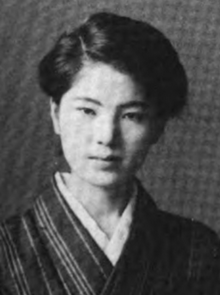Sumie Mishima
Sumie Mishima | |
|---|---|
 Sumie Seo (later Mishima) as a student in the 1920s | |
| Born | Sumie Seo 1900 |
| Died | 1992 |
| Other names | Mishima Sumie, Seo Sumie |
| Occupation(s) | Educator, writer, translator |
Sumie Seo Mishima (1900 – 1992) was a Japanese educator, translator, and writer. She is best known for two memoirs in English, My Narrow Isle (1941) and The Broader Way (1953).
Early life and education
Seo was born into a samurai-class household near Osaka; her father was a teacher who studied in the United States. After her father died, she lived in her grandfather's household,[1] and then with a paternal aunt in Tokyo.[2] She graduated from Tsuda College, and spent five years in the United States, in part to avoid family pressures to marry.[3][4] She attended Dana Hall School, and Wellesley College in 1927.[5]
Career
Mishima taught at her alma mater, Tsuda College,[5] and gave private lessons in English.[6] She translated a volume of historical legal documents, and other titles.[5] She worked as a translator for the defense at the war crimes tribunals after World War II.[7]
Mishima wrote two memoirs in English.[8] The first, My Narrow Isle (1941), was reviewed in The Atlantic and The New York Times.[9] Her second memoir, The Broader Way (1953), covered her experiences in Tokyo during and after World War II;[3][10] it was described by one American reviewer as "the most important book to be written in English by a Japanese woman since the end of World War II."[11] An Australian reviewer found it "an intensely personal account of one Japanese housewife's journey through a world war and a revolution in social custom."[7]
In 1942, her Wellesley classmate Ruth Tilford Clowes profiled Mishima as a woman "caught between worlds".[6] Ruth Benedict considered Mishima's My Narrow Isle in The Chrysanthemum and the Sword (1946), and anthropological study of Japanese culture in the mid-twentieth century.[12]
Publications
- My Narrow Isle: The Story of a Modern Woman in Japan (1941)[13]
- The Broader Way: A Woman's Life in the New Japan (1953)[14]
Personal life
Seo married Hajime Mishima, a professor of Chinese studies who had four young children from his first marriage.[5][6] She died in 1992, in her nineties.
References
- ^ Crowe, Mildred R. (August 24, 1941). "Woman Against Japan". Chattanooga Daily Times. p. 47 – via Newspapers.com.
- ^ Woods, Katherine (February 16, 1941). "A Japanese Woman's Changing World: 'My Narrow Isle' is a Personal Record of Unusual Interest". The New York Times Book Review. p. 9.
- ^ a b Kelsky, Karen (2001-11-21). Women on the Verge: Japanese Women, Western Dreams. Duke University Press. pp. 46–50, 75–76. ISBN 978-0-8223-2816-2.
- ^ Shannon, Christopher (2001). A World Made Safe for Differences: Cold War Intellectuals and the Politics of Identity. Rowman & Littlefield. pp. 9–10. ISBN 978-0-8476-9057-2.
- ^ a b c d "Sumie Seo ('27)". Wellesley College. Retrieved 2024-11-15.
- ^ a b c Clowes, Mary Tilford (September 13, 1942). "The Story of Sumie Seo, Caught Between Worlds". The Courier-Journal. p. 28 – via Newspapers.com.
- ^ a b Robinson, Peter (July 17, 1954). "Freedom for Women". The Sydney Morning Herald. p. 16 – via Newspapers.com.
- ^ Robins-Mowry, Dorothy (2019-06-18). The Hidden Sun: Women Of Modern Japan. Routledge. p. 1868. ISBN 978-1-000-30215-8.
- ^ Chamberlin, William Henry (1941-04-01). "My Narrow Isle". The Atlantic. ISSN 2151-9463. Retrieved 2024-11-15.
- ^ Frost, Peter K. (2024-03-28). Nation Building in Japan, 1945–1952: The Allied Occupation and the US-Japan Alliance. Taylor & Francis. ISBN 978-1-040-00439-5.
- ^ "A Vivid Picture of Suffering in Tokyo During and After War". The Lexington Herald. June 7, 1953. p. 39 – via Newspapers.com.
- ^ Benedict, Ruth (2021-11-11). The Chrysanthemum and the Sword. Rare Treasure Editions. ISBN 978-1-77464-443-0.
- ^ Mishima, Sumie Seo. (1941). My narrow isle; the story of a modern woman in Japan. New York: The John Day company.
- ^ Mishima, Sumie Seo. (1971). The broader way; a woman's life in the new Japan. Westport, Conn.: Greenwood Press. ISBN 978-0-8371-5797-9.
External links
- A portrait of Sumie Mishima in the 1950s, photographed by Clara Sipprell, in the collection of the Amon Carter Museum of American Art
- Sumie Mishima among other Wellesley College alumnae in 1950, from the Wellesley College Japanese Alumnae Corner
